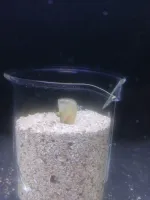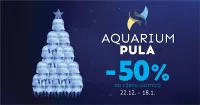Yesterday, July 17, we transferred a juvenile “spiny fan mussel” (Pinna rudis) from the quarantine section to the “Noble Sanctuary” exhibition in the Mediterranean display at Aquarium Pula. She was found in the Telašćica Nature Park on May 17 during fieldwork as part of the national project “Conservation of the Noble Pen Shell (Pinna nobilis) in the Adriatic Sea.” Upon arrival, she was only 1.7 cm long, and thanks to abundant food and care from our staff, she doubled in length to 3.1 cm within the first two months and continues to thrive.
Pinna rudis is a native species of the Mediterranean and eastern Atlantic, and its range is expanding due to rising sea temperatures. It is resistant to the parasite Haplosporidium pinnae, which caused the near-complete disappearance of Pinna nobilis populations across the Mediterranean. The first Pinna rudis individuals were observed in Montenegro in 2021, and since then, the species has been spreading steadily. Today, higher densities are observed in the southern Adriatic, with gradual expansion into the central and northern Adriatic.
In the Adriatic, three legally protected pen shell species can be found:
Noble pen shell (Pinna nobilis): The largest species, reaching up to 120 cm in length. It has a triangular shape with a semi-circular tip and a surface covered with dense, fine spines, most pronounced in juveniles. Its byssal threads, which emerge from the base (umbo) to attach to the substrate, are well-developed.
Spiny fan mussel (Pinna rudis): Grows up to 60 cm, reddish-brown in color, with robust spines arranged in 5 to 8 longitudinal rows. The shell is triangular, and unlike other pen shells, it prefers rocky habitats.
Fragile pen shell (Atrina fragilis): Reaches up to 40 cm in length. The shell is thin and fragile, triangular with a flat tip, and lacks spines. Concentric growth lines are visible along the shell, with a darker area around the base.






























